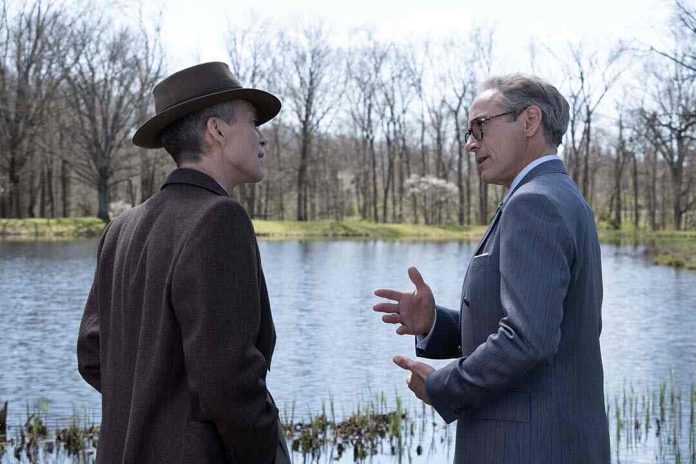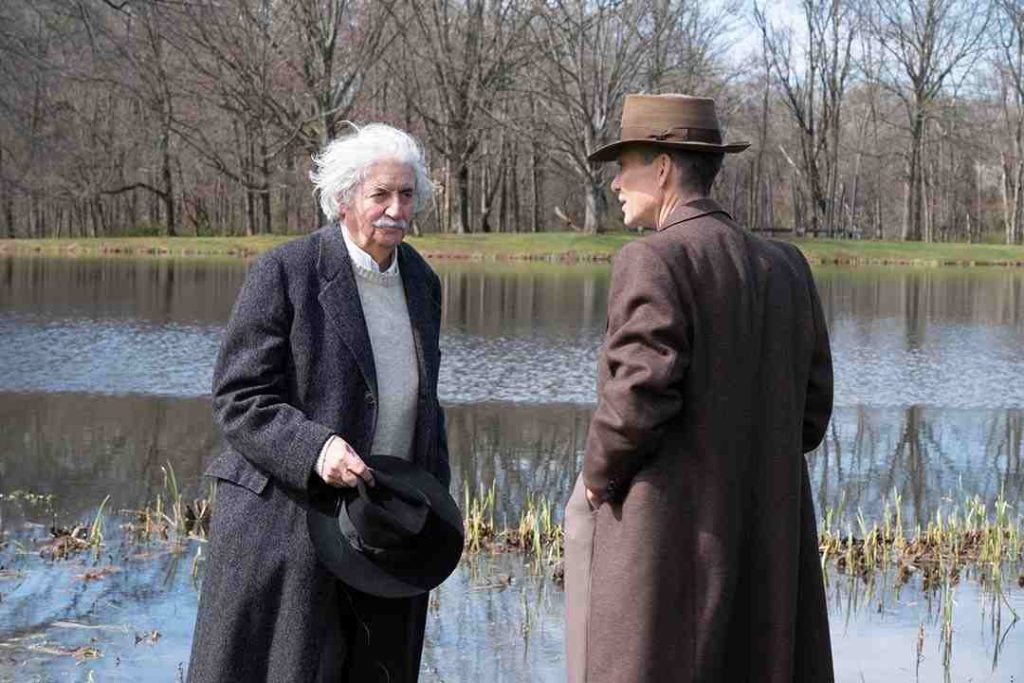Hollywood’s summer blockbuster Movie is Christopher Nolan’s Oppenheimer. In this movie, we delve into the unyielding examination of J. Robert Oppenheimer’s life in the public eye. In this gripping narrative, we delve into a tale filled with moments of sheer joy, bone-chilling horror, and heart-wrenching tragedy, all revolving around the creation of the Atomic Bomb. This story goes beyond the typical biography of Oppenheimer’s life.
What happened in Oppenheimer Movie (2023)?
Oppenheimer (Cillian Murphy), is shown at the start of the film studying in the Cavendish Laboratory with the strict instructor Patrick Blackett. Oppenheimer, who is homesick and anxious, gives Blackett a poisoned apple but saves Niels Bohr from eating it by acting quickly. Following the completion of his physics Ph.D., Oppenheimer goes home due to a dearth of quantum physics research prospects. He rises to prominence in the scientific world, spending time at the California Institute of Technology and lecturing at the University of California, Berkeley. He meets key people along the way, including Nobel Prize laureate Ernest Lawrence, who stresses the significance of real-world applications in science.
Oppenheimer becomes connected with Jean Tatlock (Florence Pugh), a member of the Communist Party USA, with whom he has an on-and-off romantic engagement, which brings politics into his personal life. Tragically, Tatlock ends up killing himself. He later weds former Communist biologist Katherine Puening.
Oppenheimer is asked to oversee the creation of the atomic bomb as part of the top-secret Manhattan Project by General Leslie Groves. To build the bomb, Oppenheimer gathers a group of scientists at Los Alamos, New Mexico, motivated by his ambition to stop the Nazis and their anti-Semitism from destroying the world.
Some scientists doubt whether it is necessary to continue the project when Germany submits, but it does so nevertheless. Just before the Potsdam Conference, the Trinity test, a significant step in the development of the atomic bomb, is successfully completed. Huge amounts of destruction resulted from President Harry S. Truman’s decision to drop atomic bombs on Hiroshima and Nagasaki. Oppenheimer meets with Truman after being devastated by the results of these attacks, and Truman considers Oppenheimer’s mental state to be weak. Truman clears Oppenheimer of blame, but Oppenheimer insists on taking responsibility for his part in developing the atomic bomb. When William L. Borden (David Dasmalchian) is brought in, Oppenheimer’s “horror” tone starts to change.
Oppenheimer’s opposition to future nuclear development, especially the hydrogen bomb, is a defining characteristic of his post-war years. However, during the Cold War with the Soviet Union, government authorities were suspicious of him because of his left-wing affiliations and friendship with Tatlock. These accusations are used by Lewis Strauss (Robert Downey Jr.) to discredit Oppenheimer, which results in the revocation of his security clearance and the exposure of his liaison with Tatlock. These occurrences cause Oppenheimer to lose favor and lose his influence.
Vice President Lyndon B. Johnson (Hap Lawrence) presents Oppenheimer with the Enrico Fermi Award in an act of political redemption. It is revealed that he had previously discussed with Einstein his concern that the use of nuclear weapons could cause a series of nuclear explosions that would bring about the end of the planet.
Oppenheimer Movie (2023) Ending, Explained!
Lewis Strauss, a character in the film, recalls a scene in which J. Robert Oppenheimer (Cillian Murphy), who had just had his hat blow off, approached Albert Einstein (Tom Conti). Oppenheimer picked up the hat and returned it to Einstein before the two men conversed. When Einstein turned to gaze at Lewis after leaving Oppenheimer, he was speechless. Strauss speculates as to what Oppenheimer might have said to have such an effect on Einstein.
This scenario is presented in black and white for the first two occasions. According to Nolan, the color scenes are subjective from Oppenheimer’s perspective whereas the black and white scenes are intended to be an objective point of view from Lewis Strauss’s perspective. In typical Nolan form, he repeats this sequence throughout the film until giving us the payoff at the very end, when we see it in color.
Oppenheimer hands Einstein his hat after picking it up. They had a brief conversation. Oppenheimer is told by Einstein about his future accomplishments, awards, and encounters with former coworkers. The characters in this film appear in a glimpse of the future when they are older. According to Einstein, “It won’t be for you; it will be for them.” After Edward Teller (Benny Safdie) gave bad evidence at the Oppenheimer security hearing, Kitty (Emily Blunt) won’t even shake his hand.
The Manhattan Project once threatened to end the planet, Oppenheimer tells Einstein as the film comes to a close. Then he adds, “I beleive we did.” We dwell on his heartbroken expression before cutting to the deployment of nuclear weapons to demonstrate how, in Oppenheimer’s opinion, the world was impacted negatively by his impact.





